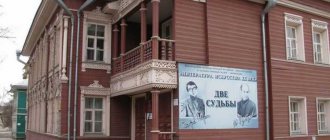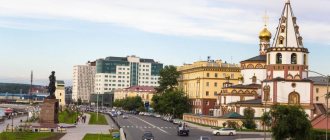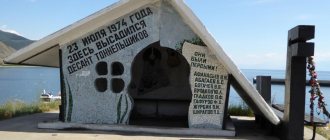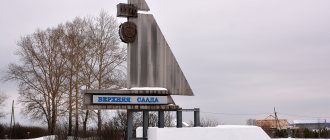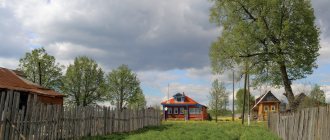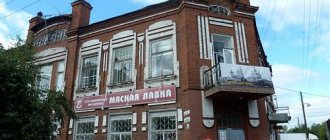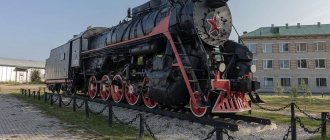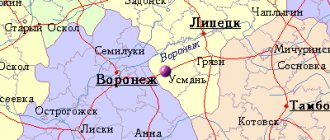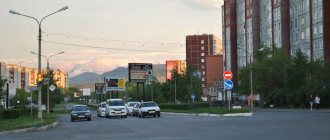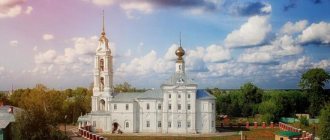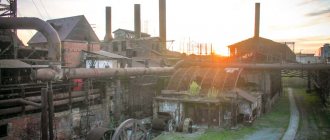In terms of area, the Arkhangelsk region is comparable to countries such as Spain or France. However, there are only one or two cities in it. But most of them have a rich history. These include Kargopol, which is the same age as Moscow. The city is small, with a population of 10 thousand people. But the flow of tourists there does not dry up. And there are reasons for this.
Coat of arms of Kargopol
Story
The first mention of Kargopol in written sources dates back to 1380. In the Nikon Chronicle there is a mention that the Kargopol prince Gleb brought his squad under the banner of the Great Moscow Prince Dmitry Donskoy and participated in the Battle of Kulikovo.
Cathedral Square
The city of Kargopol itself (in the ancient acts of Cargo Field) was mentioned in 1447, when Dmitry Yuryevich Shemyaka found refuge here, fleeing the persecution of Grand Duke Vasily the Dark.
There is no doubt that Kargopol was founded much earlier than the end of the 14th century. The banks of the Onega River, one of the routes to Pomorie, were occupied by Novgorod colonists already in the 12th century, and monasteries appeared in the middle of the 14th century.
Apparently, initially the Kargopol settlement depended on the Belozersk principality, and later came under the rule of Novgorod
With the subordination of the Novgorod land to the Moscow principality in 1478, the lands along the Onega River to the White Sea formed the Kargopol district under the control of the Moscow governor.
In the 16th century, Kargopol was a significant trading city. A new fort was erected and the settlement was built up. In 1506, Grand Duke Ivan III gave Kargopol to his son Vasily in his will. In 1539, the city received a provincial charter, which granted it broad rights to local self-government.
In 1538, the sister of Elena Glinskaya’s favorite, boyar Telepnev-Ovchina Agrafen, was exiled to Kargopol.
In 1565, Ivan IV the Terrible announced the introduction of oprichnina in the country. The country was divided into two parts: “To the Sovereign's Grace Oprichnin” and the zemstvo. The Oprichnina included mainly the northeastern Russian lands, where there were few patrimonial boyars. When Kargopol was classified as an oprichnina, there were 476 households of tax-paying people.
Nikolskaya (New Trade) Square
In 1612, Kargopol fought off attacks by “Polish and Lithuanian people and Russian thieves,” and in 1614 withstood a long siege by the Cossacks.
Reign of Peter I
In 1703, Kargopol was assigned to the Olonets shipyard, in 1708 - to the Ingermanland province.
In 1727, a separate Novgorod province was created. As part of it, the Kargopol district became a district in the Belozersk province.
Reign of Catherine II
In 1776, by decree of Catherine II, the Kargopol district became part of the Olonets province of the Novgorod governorship.
In 1784, during the administrative reforms of the era of Catherine II, the Olonets governorship was separated from the St. Petersburg province, which included 8 counties, including Kargopol.
During the short reign of Paul I (1796-1801), the Olonets governorship was abolished, and the Kargopol district was returned to the Novgorod province.
Since 1801, Kargopol has been a district town of the Olonets province.
The city at the turn of the 19th—20th centuries
There was a zemstvo hospital with 45 beds, an almshouse for 30 people and an orphanage with a craft class for teaching boys bookbinding and carpentry.
Resurrection Church
The education sector was represented by a men's religious school (founded in 1809) with 51 students, a city 3-grade school with 100 students, and a women's parish school with 73 students.
There were 11 stone houses, 331 wooden houses, 7 shops for storing goods, 37 shops; 1 distillery, 1 vodka, 1 brewery and 3 furriers. Their production reached the amount of 62,000 rubles.
The 2nd guild issued 30 merchant certificates, 14 for petty trading, and 16 for trade certificates. There was a Public Bank, weekly bazaars and 2 fairs, a club, a society for the improvement of people's labor in memory of Tsar-Liberator Alexander II, with whose funds a class was opened at the city school manual labor, a charitable society and Holy Spirit parish guardianship.
The main industry - the manufacture of squirrel furs, which were sold at the Nizhny Novgorod fair, gradually fell. In the 70s of the 19th century, up to 2 million squirrels were produced, by the end of the 19th century - no more than 150,000.
On the banks of Onega
Kargopol is located in the southwest of the Arkhangelsk region. Of all the cities in the region, it is the closest to the “mainland”. However, the Kargopol region is equated to the regions of the Far North. The city is located on the left bank of the Onega River, not far from Lake Lacha. The railroad bypassed him. The nearest Nyandoma station is 80 kilometers away.
A highway passes through the city, connecting it with Arkhangelsk. The distance to the regional capital is 493 kilometers, to Moscow - 830 kilometers, to St. Petersburg - 640 kilometers. The presence of a highway significantly increases the transport accessibility of Kargopol.
Onega River
The territory of the region is a slightly hilly plain. You won't find mountains here. At one time, the glacier did a fair amount of work on the landscape, ironing and smoothing everything out. And when he left, he left behind small depressions. They filled with water and turned into lakes. Some of the reservoirs eventually became swamps. The subsoil of the western part of the region is composed of limestone and marls, so karst voids and sinkholes are found in these places.
Onega is the main river of the region and the decoration of Kargopol. Within the city its width reaches 300 meters. There is a large island in the central current on the southern outskirts of the city. On the northeastern outskirts, the Shorshma River flows into Onega. The depth of Onega ranges from two to four meters. The flow speed is low - it carries 74 cubic meters of water per second. Ice on the river appears at the end of October and disappears in mid-April.
Six kilometers south of Kargopol lies Lake Lacha, where Onega originates. This section of the river is navigable. Rafting enthusiasts love to come here. The banks of the river are usually high and covered with forest. Lake Lacha is very rich in fish. It accounts for 30% of all lake fish caught in the Arkhangelsk region. Bream is considered the main commercial fish. The length of the lake is 33 kilometers, width is 14 kilometers, average depth is 1.6 meters.
Lake Lacha is very rich in fish
The local climate cannot be called heavenly. Otherwise, how would the area be included in the list of territories of the Far North. In Soviet times, local residents were paid a salary premium for the harshness of the climate. Air humidity reaches 80%. This is due to the proximity of the White Sea. Winter is long. The average temperature is minus 12 degrees. However, frosts down to minus 43 degrees occur. Summer is short and cool. The average July temperature is plus 17 degrees. Most precipitation falls in July and August.
Soviet Russia
In January 1918, the RSDLP(b) organization arose in Kargopol. Soviet power was established.
Lenin monument
On April 30, 1919, the Kargopol district was transferred from the Olonets province to the Vologda province.
From the survey report of the GPU information department No. 49 (217) for May 11, 1923:
“Vologda province. (State Information Report No. 1147, May 4). The attitude of the peasants of the Kargopol district towards the Soviet government and the Russian Communist Party is hostile due to the developing famine. Many peasants in this district, due to the lack of bread, mix various surrogates into flour. Hunger and tax collections force many peasants in the Kargopol district to abandon their farms and go to the city to earn money. The peasants of Kargopol are intimidated by inventories and other repressive measures. Acute discontent among the peasants is caused by the distribution of 1 thousand poods of the remaining grain among the employees of the provincial food committee in the form of a bonus upon its liquidation, while the peasants who came to the city from distant places could not beg from the pre-executive committee a few poods of bread for sowing the fields.”
In 1937-1940, the Kargopollag administration was located in Kargopol, whose prisoners were engaged in logging.
In the 1940s, an airport was built to the west of the city.
In 1963-1965, Kargopol was the center of the Kargopol rural district.
Natural wonders
In the vicinity of Kargopol, on one of the roads you can see an unusual wooden sign in the form of a harp with the inscription “White Sea-Baltic watershed”. The road goes along a ridge about 10 meters high. It is a natural formation and separates two lakes - Maselga and Vilna. All rivers on the western side of the ridge flow into the Baltic Sea, and from the eastern side into the White Sea.
And near the village of Morshchikhinskaya, on the banks of the picturesque Lekshmozero, you can see a mysterious artifact called “Nikolin’s stone”. Its strangeness is that on the flat surface of the giant boulder there is a depression in which there is always water even in the driest time of the year. It is believed that if you rinse your eyes with this water, your vision will become sharper. The folk trail to the stone is never overgrown.
This is how guests are greeted
The disappearing Khalui River is considered a natural attraction. Imagine a water stream that suddenly disappears and appears from underground only after one and a half kilometers. According to legend, the mysterious phenomenon was formed at the behest of St. Alexander of Osheven. He wanted to establish a monastery in this place, but the local residents drove him away. Alexander is said to have responded by saying: “You will live by the water, but without water.”
Economy
- Dairy plant
- Bakery
- Forestry enterprises: JSC "Les", JSC "Kargopolles"
Development prospects
There are tendencies of predominantly negative dynamics of economic development. This is due to the great distance from Arkhangelsk, the low transport development of the territory and the uncompetitiveness of the enterprises' products.
The city's economy could develop through the development of forestry or the wood processing industry, but due to poor development of transport infrastructure and distance from export ports and markets, the chances for further development are slim.
The richest tourism opportunities of the region (medieval architecture of the city, wooden architecture, Kenozersky National Park) are almost not used.
Population
As of January 1, 2022, in terms of population, the city was in 922nd place out of 1,115 cities in the Russian Federation.
In 1858, 1065 men and 1003 women lived in Kargopol, the total population of the city was 2068 people. At the turn of the 19th - 20th centuries, there were 2,712 residents in the city; of these, hereditary nobles - 130, personal - 209, clergy - 110, honorary citizens - 33, merchants - 74, burghers - 1570, peasants - 370, military servants - 113, retired - 31, reserve lower ranks - 48, foreigners - 1 (German Varner), commoners - 11. There were 2689 Orthodox, 14 Catholics, 9 Lutherans. There were 17 Orthodox churches (including 15 stone ones), 3 chapels.
Local dialect
The local dialect belongs to the group of Lach dialects of the northern dialect. It’s interesting that despite the proximity of the Vologda region, no one comes here anymore. In the dialect of local residents (as well as in the dialect of native Petersburgers), the forms of the dative and instrumental cases of the plural of nouns and adjectives are distinguished, and the pre-stressed o is pronounced as a narrow “a”.
Sights of Kargopol
- Ensemble of Cathedral Square: Nativity Cathedral (1552-1562) - Object of cultural heritage of the Russian Federation No. 2910038002 architectural monument (federal)
- Bell tower on Cathedral Square (1765-1778) - Object of cultural heritage of the Russian Federation No. 2910038001 architectural monument (federal)
- Church of the Presentation (1802-1810) - now the Kargopol State Historical, Architectural and Art Museum Object of cultural heritage of the Russian Federation No. 2910038003 architectural monument (federal)
- Church of John the Baptist (1740-1751) - Object of cultural heritage of the Russian Federation No. 2910038004 architectural monument (federal)
- Annunciation Church (1682-1692) - Object of cultural heritage of the Russian Federation No. 2910037001 architectural monument (federal)
How to get there
You can get to Kargopol by car, bus and train. From Moscow and Vologda by car you should travel to Velsk along the M8 federal highway, and then along the P2 road through Dolmatovo and Nyandoma. The M8 highway leads from Arkhangelsk, then you should turn onto the P1 road and drive through Brin and Plesetsk. There are two ways from St. Petersburg - through Vologda and Pudozh.
An intercity bus service connects Kargopol with Arkhangelsk, Severodvinsk and Nyandoma. Since the railway runs 80 kilometers from the city, you should buy a train ticket to Nyandoma station. Trains from Moscow, St. Petersburg, Vologda, Kotlas and Arkhangelsk pass through it.
Attractions in the vicinity of Kargopol
West of town
- Church of the Presentation of the Lord and the Archangel Michael in the village of Krasnaya Lyaga (1655). The wooden church, covered with planks from the 19th century, has not been restored. The oldest architectural monument of the Kargopol region. The village has disappeared by now, the church stands in a small grove among the fields. (61°35′56″ N 38°39′39″ E / 61.59889° N 38.66083° E (G ) (O)). Panorama of the church.
- Wooden temple complex in the village of Lyadiny (Gavrilovskaya) (61°33′38″ N 38°19′20″ E / 61.56056° N 38.32222° E (G) (O)) . Photos of the complex. The five-domed Epiphany (St. George) Church (1793), the only surviving structure of the complex. In 2010, it was partially disassembled for restoration; as of June 2015, it was restored, paneled and painted.
- Intercession-Vlasievskaya tent church (1743, burned down in May 2013).
- Tent bell tower (XVIII century, burned down in May 2013).
North of town
- Wooden tented church of St. John Chrysostom with a free-standing bell tower in the village of Saunino (Kiprovo) (1665). (61°33′09″N 38°55′43″E / 61.55250°N 38.92861°E (G) (O)). Photos of the church.
- Temple complex in the village of Arkhangelo (Shelokhovskaya). The wooden five-domed cuboid Church of the Archangel Michael (1715) and the wooden single-domed Sretenskaya Church (1803). The stone bell tower has been lost. (61°54′38″N 39°06′18″E / 61.91056°N 39.10500°E (G) (O)). Panorama of the complex.
- Architectural monuments of the village of Oshevenskoye: Alexander-Oshevensky Monastery. A complex of stone buildings: the Cathedral of the Assumption of the Virgin Mary (1707), the gate church of St. Nicholas the Wonderworker (1834), monastery buildings, the remains of a fence. (61°51′31″N 38°46′50″E / 61.85861°N 38.78056°E (G) (O)). Photos of the monastery. Panorama of the monastery.
- Wooden tented Epiphany Church with a free-standing bell tower in the village of Pogost (1787). (61°51′52″N 38°46′41″E / 61.86444°N 38.77806°E (G) (O)). Photos of the church.
- Wooden St. George Chapel in the village of Niz (19th century). (61°52′52″N 38°45′21″E / 61.88111°N 38.75583°E (G) (O)). Photos of the chapel.
East of town
- Temple complex in the village of Bolshaya Shalga (Kazakovo village). The wooden tented Church of the Nativity of Christ (1745) and the stone Church of the Intercession of the Blessed Virgin Mary (1857). (61°30′17″N 39°07′01″E / 61.50472°N 39.11694°E (G) (O)). Panorama of the complex.
Name
The name of the city is a semi-calculation - a phenomenon characteristic of the toponymy of the Russian North, when the substrate Baltic-Finnish name is half translated into Russian. The second part of the word Kargopol
is a translated approx.-f.
pelda
"field". There are several versions regarding the first part of the name:
- Cargo
- in the northern dialects “crow”, therefore,
cargo field
- “crow field”; - From Karelian Karhupeldo
"bearish side".
Folk art of Kargopol
From the second half of the 19th century, researchers often began to come to the Kargopol land. Architectural monuments are measured, drawn, photographed by F. F. Gornostaev and V. V. Suslov, I. Ya. Bilibin and I. E. Grabar. Storytellers and songwriters are recorded by P. N. Rybnikov, A. D. Grigoriev, V. F. Miller, N. S. Tikhonravov and A. F. Gilferding.
Local enthusiasts also collect works of folk art and folklore. The rich collection that laid the foundation for the Museum of Local Lore was collected by K. G. Kolpakov. Many thousands of fairy tales, proverbs, spells, songs, ditties were preserved for descendants by E. A. Orlov and M. V. Khvalynskaya.
In 2007, the Library of the Russian North was opened in Kargopol. It is based on the personal library of G. P. Gunkin, donated to the museum by the writer’s widow.
Kargopol is famous for folk art - the Kargopol clay toy and many other types of folk art: ancient Russian painting and sculpture, wood carving and painting, cube heeling (fabric dyeing), patterned weaving and embroidery.
Museum courtyard
The Kargopol Historical and Architectural Museum has an interesting history. On its gate it is written: “Museum courtyard.” It was formed in 1919. The exhibition was based on the collection of tradesman Kapiton Kolpakov. Now it is the calling card of the city. It includes not only antiques and documents, but also entire buildings - a total of 11 buildings in the city and surrounding villages. Interactive programs are organized in the museum courtyard. Every year the Crystal Bells festival takes place.
Model of a salt boiler
In the Lyadinsky Patterns museum you feel like you are in an old village house. Antique clothes, kitchen utensils, household items - everything was lovingly collected from Kargopol villages. In the museum you can learn about how in the old days they processed flax, wove, and sewed clothes. The exhibition includes samples of patchwork and embroidery. For those interested, master classes on making amulets dolls, thread mosaics and weaving sashes are organized.
Kargopol is located in the north, where in winter there is no skiing and neither here nor there. There is no place here without a ski museum. It is located on a street with a completely unwinterish name - “Lilac”. The exhibition presents skis of all times - from simple products of the 19th century to modern “rollers”. There are also hockey uniforms, sticks, and sports awards. In winter, there is a skating rink outside, and you can rent skates right at the museum.
Kargopol amulet doll
With children, you should definitely visit the fabulous eco-park “Bear Land”. It is located on the shores of Lake Lache. Guests are greeted by a sculpture of a bear with a balalaika. Funny figures are placed throughout the park. In the very center there is a hut in which a whole family of bears lives. The park has an exhibition of stuffed birds and animals, a souvenir shop and a workshop for making carved frames. In winter, the park is decorated with numerous ice sculptures.
Famous people associated with Kargopol
- Baranov, Alexander Andreevich - Russian merchant, founder of trading posts in Russian America, born in Kargopol
- Gunkin, Genrikh Pavlovich - writer, author of books about the Kargopol region
- Hilferding, Alexander Fedorovich - Russian Slavic scholar, folklorist, died in Kargopol.
Share link:
- Click here to share content on Facebook. (Opens in a new window)
- Click to share on WhatsApp (Opens in new window)
- Click to share on Pinterest (Opens in new window)
- Click to share on Skype (Opens in new window)
- Click to share on Telegram (Opens in new window)
- Click to share on Twitter (Opens in new window)
- Click to share posts on Pocket (Opens in new window)
- Click to share on Reddit (Opens in new window)
- Click to share on LinkedIn (Opens in new window)
- Click to share posts on Tumblr (Opens in new window)
- Send this to a friend (Opens in new window)
- Click to print (Opens in new window)
Interesting Facts
The Kargopol merchant Alexander Andreevich Baranov deserves special mention.
This famous industrialist in 1790 took the post of the first ruler of Russian America at the suggestion of G. Shelikhov, one of the organizers of the North-Eastern (later Russian-American) company. Taking into the service of a young tradesman from Totma, Ivan Aleksandrovich Kuskov, Baranov went to Alaska and in 1796 on the island of Sitkha founded the official capital of the Russian possessions - Novo-Arkhangelsk, where he settled permanently. Tours to Kargopol
Coat of arms
The coat of arms was approved by the Empress Catherine II on August 16, 1781.
“In a blue field, a natural-colored ram lying on fire on wood.”
Description of the coat of arms: “In an azure (blue, light blue) field there is a silver ram with golden horns, lying on golden brands; everything is engulfed in scarlet (red) flames with a thin golden border.” According to one version, the image of a ram on fire symbolizes a connection with the pagan ritual of sacrificing a ram, which was widespread in the Russian North. In some parishes of the Kargopol district there was a “ram Sunday”, during which peasants slaughtered a ram and sacrificed it to Elijah the prophet. Perhaps this ritual was the basis for the coat of arms of 1781. According to another version:
One of the Russian regiments was the Kargopolsky, for which the emblem of the sacrificial lamb was chosen - a well-known Christian symbol. Obviously, from the banner of the Kargopol regiment, the ram (lamb) migrated to the coat of arms of the city.
The modern version of the coat of arms was approved on June 30, 2004 (Number in the Heraldic Register of the Russian Federation: 1511). The authors of the new coat of arms are Konstantin Mochenov, Galina Tunik and Yuri Korzhik.
Power and politics
The city houses both the administration of the Kargopol urban settlement and the administration of the Kargopol municipal district.
Local government
The formation and activities of local government bodies are established by the charter of the Kargopol urban settlement.
- Council of the Kargopol urban settlement.
- Head of the urban settlement Bubenshchikova Natalya Vladimirovna.
- Administration of Kargopolskoe urban settlement.
Today's day
Roads, transport
The main and only reliable way to get to Kargopol is by train to the Nyandoma station of the Vologda - Arkhangelsk railway (direct communication with Moscow and St. Petersburg) and then by bus to Kargopol (4 trips per day, 78 km).
Kargopol, as already noted in the section on the history of the city, is located at the intersection of a large number of roads. However, only one of them is in good condition - to the nearest railway station Nyandoma. “Nearest” is a strong word – it’s a good 80 km away. There is a legend that says that the merchants of the city of Kargopol specifically asked not to build a “demonic” railway through their city. The motivation of these merchants is not entirely clear - it is unlikely that they cared about the environment. And, to be honest, this story looks very far-fetched, since at the beginning of the 20th century (when the railway was built) Kargopol was a “bear corner” and there were no such special “merchants” in it for a long time. Perhaps this was the case: the board of the railway offered these same merchants to give a large bribe in order to make a detour to Kargopol, but, of course, there was no money and the railway was laid from Vologda to Arkhangelsk almost in a straight line.
| Border of Karelia and Arkhangelsk region. Khabanzya River. Federal highway P2, model August 1999. Photo by A. Tilipman. |
Yes, so, the Nyandoma-Kargopol highway, being part of the federal highway P2, is, by the standards of the Arkhangelsk region, in excellent condition. Its continuation from Kargopol to Pudozh was until recently (November 1999) passable on the border with Karelia only in winter, when the road froze. This is what the route looked like at its intersection with the border mentioned above during the driest time of summer (see photo).
Another important road (P1) goes from Kargopol south to Vytegra and further to St. Petersburg. Its condition is much better - in dry summers it is quite passable by cars. The problem area, as one would expect, is on the border with the Vologda region. The continuation of this road from Kargopol to the north leads to Plesetsk and further to Arkhangelsk. The condition is acceptable, the bridges exist and are functioning.
Local roads lead to Oshevensk, Nokola and Voloshka. There is only one bridge across the Onega River. A giant bypass road has been built around the left bank of the city. Accordingly, there are no transit traffic flows through the city. However, in the vicinity of Kargopol there are no flows of any transport at all. Fortunately, despite the construction of the new Pudozh-Kargopol highway, the only road connecting Karelia with the Arkhangelsk region, the situation has not yet fundamentally changed. However, the restless builders are not going to stop there - in the future this road should become part of some kind of trans-European route, starting somewhere in Finland and ending in the regional center of the Vologda region called Nyuksenitsa (this is not a joke). In the future, this highway will reach Kirov. The countdown has begun a long time ago - less than 3 years are left until the opening of the route.
The city bus station (tel. 2-13-18) is located in the northern part of the city, about 50 meters from the Trinity Church, whose huge dome, shaped like a hemisphere, serves as an excellent landmark. There are 4 buses a day to Nyandoma station, connected to the main trains to Moscow and Arkhangelsk. Other bus routes are extremely irregular, many of them operate 3-4 days a week. Taxi drivers are constantly on duty at the bus station, ready to take you anywhere, anytime. When any stranger appears on foot, they jump out of ambush, vying with each other to offer their services. If refused, they are offended, but do not give up hope.
To the west of the city there is a fully functional airport (tel. 2-11-61), but passenger transportation has not been carried out for a long time. It is characteristic that back in the 80s of the 20th century there were 4 (!) weekly AN-2 flights from Kargopol to Arkhangelsk, 1 flight per week to Leningrad, local flights to Pudozh and Velsk. All that remains of its former greatness is the fireman's corn mash. A couple of times a year a helicopter arrives with tourists from Petrozavodsk.
The city marina is also not functioning and is tightly closed. Previously, a passenger ship sailed from it along Lake Lache to Nokola and further up the Svid River. Now there is a perpetually drunk grandfather living there who makes his living as a fisherman. It is absolutely unclear where the ship went - it is impossible to go down the Onega to the sea due to the rapids. For the same reason, it is not clear how this ship was born there in the first place.
Locals
The population is quite friendly, but not as nice as in many other small towns in the North. This is probably due to the proximity of a large number of camps and “free settlements” in the neighborhood. Accordingly, some faces can make a lasting impression on an unprepared person. From time to time there are drunk people, but still no one bothers you on the street. Service workers often try to shortchange; When caught, they turn deep red. It’s interesting that despite the proximity of the Vologda region, no one comes here anymore. Only occasionally does one encounter a feature of pronunciation that was once characteristic of these places, when instead of the sound “ch”, “ts” is used - for example, “tsasovenka”.
Of all 11 churches, only one is operational (tel. 2-19-36), and even that one is not crowded with people. It is worth mentioning that every day at exactly 12 o’clock in any weather, a handsome young man named Oleg Panteleev, a guitar teacher at a music school, climbs the city bell tower and announces the melodious ringing of 10 bells around the area. In general, the number of pleasant personal contacts in Kargopol is noticeably greater than unpleasant ones. In few other cities, the deputy head of the city police department, a police major, is interested in weaving birch bark.
City life
| Photo by V. Nikitin. |
In terms of food prices, life in Kargopol has definitely become easier over the past few years. Agriculture is gradually emerging from the decline that befell it in the mid-90s of the 20th century. Prices for many products have become equal to or even lower than in Moscow. If in 1999 bread in Kargopol cost one and a half times more than in Moscow, now the situation is exactly the opposite. What is especially pleasant to note is that the quality does not suffer at all, and even vice versa. The dairy started working again. The milk produced by him is worthy of the warmest words. However, it is better to buy sour cream made in Velsk. The latter is not inferior to the best Vologda samples.
The city has not been affected by gasoline crises lately, which again has a positive effect on life. The first modern gas station appeared in the city, on the bypass. Even if this happened only in the third millennium, it still happened. Of course, in the neighboring Vologda region, life is significantly cheaper, but compared to how things were just recently, progress is obvious.
There are, however, some negative sides to this. Thus, at many retail outlets new, clumsy signs have appeared, which are a striking contrast to the surrounding reality and are significantly inferior in artistic terms to the old signs. The charming mansion on the north side of the New Market Square suffered the most from inept advertising.
Over the past couple of years, a great variety of shops have appeared in the city. Sometimes it may seem that there are more retail spaces in Kargopol than residential ones. Their entrance doors require special attention. In order to reduce the time of their slamming, springs of such high rigidity as can be found are used. It is clear that the climate is harsh and coal is expensive. It is also clear that well-developed arm muscles and agile legs have never harmed anyone.
Compared to the amazing number of shops and stores, public catering looks more than pale. There is a rather modest diner with a modest selection of dishes and equally modest prices, but equipped with a microwave oven. All sorts of different pies deserve attention, the value of which increases markedly with the presence of a microwave. Also good is borscht and, the apotheosis of wastefulness, oven-baked meat in a pot for 20 rubles. The diner is open from 9 to 22, and on weekends until midnight. The same assortment at the same prices, but in a much more pretentious setting, is available on the second floor of the same building. But - only a few hours during the day, and even on weekend nights. Another snack bar appeared in the building of the Kargopolochka hotel. Previously, there was a full-fledged dining room there, now it is under permanent renovation, and the diner does not stand up to any criticism.
As for accommodation, there is little choice here either. You can stay at the hotel mentioned above, proudly calling itself “Business Lache”, located in the northwestern part of the city on the outskirts. It is much cheaper to live in it, but it has no running water or sewerage system. This is not a problem incompatible with life, but it may require some time to develop certain skills. But the management of the camp site certainly deserves good words for the warmth of the welcome, both figuratively and literally. If you come in winter, they will definitely heat the stove for you.
| Crows nest inside leaky domes. Photo by A. Tilipman. (August 1999) |
The structure of the city laundry or, if I may say so, the “laundry room” is curious. As usual, most of the city lacks running water. For some aesthetic reasons, the absence of this benefit of civilization does not eliminate the need for washing. Usually in such cases, the clothes are washed in the nearest accessible body of water, for which a special hole is cut in winter, as, for example, in Kirillov. In Kargopol, the townspeople are extremely lucky - they are spared the need to cut ice even in the most severe frosts! And that's why.
From a completely flat and even bank of the Onega River, at a distance of 10-20 meters from the river itself, a series of very powerful springs emerge from a considerable depth. The reasons for this phenomenon are discussed in detail in the article about the Kargopol Sush, but for us now the only important thing is that these springs are extremely clean and, moreover, do not freeze even in the most severe frosts, which are not uncommon here. A covered wooden pavilion with wide openings in the floor and railings was built above some of these springs - so as not to follow the laundry. The laundry room is located next to the pier and the New Trade Square. In front of the entrance there is a sign with the inscription “Do not wash cars!”
There are 3 secondary schools in the city, plus one sports school and one art school.
You can find out about the weather in Kargopol at the weather station by calling 2-12-26.
